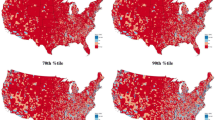Abstract
While the factors that influence college minority student attendance have been the subject of recent study, there remain unresolved questions about how different factors influence college attendance decisions of applicants from historically disadvantaged backgrounds. In particular, there is ambiguity about whether blacks are more or less likely to attend than whites and what factors might improve their attendance rates. This study uses two sets of logistic regressions to identify the factors that can promote minority attendance: a set that examines attendance by all high school seniors in the high school class of 1982 and a set that examines attendance by college applicants in this class. Consistent with prior research on student access, three factors are identified that can potentially improve college attendance by minority students: (1) improved academic preparation in elementary and high school; (2) increased aspirations for higher levels of educational attainment; (3) increased levels of financial aid. Public interventions that would improve any of these factors for minority high school students are likely to improve minority participation rates.
Similar content being viewed by others
References
Aldrich, J. H., and Nelson, F. D. (1984).Linear Probability, Logit and Probit Models. Beverly Hills: Sage.
Alexander, K., and Eckland, B. (1975). Basic attainment processes: A replication and extension.Sociology of Education 48(fall): 457–495.
Alexander, K. L., Holupka, S., and Pallas, A. M. (1987). Social background and academic determinants of two-year versus four-year college attendance: Evidence from two charts a decade apart.American Journal of Education 96(1): 56–80.
Chaikind, S. (1987).College Enrollment Patterns by Black and White Students. Prepared for the Planning and Evaluation Service, U.S. Department of Education. Washington, DC: DRC.
Eckland, B. K., and Alexander, K. L. (1980). The national longitudinal study of the high school senior class of 1972.Research in Sociology of Education and Socialization 1: 189–222.
Freeman, R. B. (1976).The Overeducated American. New York: Academic Press.
Hopfenberg, W. S., Levin, H. M., Meister, G., and Rogers, T. (1990).Toward Accelerated Middle Schools for At Risk Youth. Stanford, CA: School of Education, Stanford University.
Hossler, D., and Gallagher, K. S. (1987). Studying student college choice: A three phase model and implications for policy makers.College and University 2(3): 207–221.
Hossler, D., and Stage, F. K. (1988). Family and high school experience factors' influence on postsecondary plans of ninth grade students. Paper presented at the annual meeting of the American Education Research Association, New Orleans, LA.
Jackson, G. A. (1978). Financial aid and student enrollment.Journal of Higher Education 49(6): 548–574.
Jackson, G. A. (1988). Did college choice change during the 1970s?Economics of Education Review 7(1): 15–27.
Leslie, L. L., and Brinkman, P. T. (1988).The Economic Value of Higher Education. San Francisco: Jossey-Bass.
Levin, H. M. (1988).Accelerated Schools for At Risk Youth. Brunswick, NY: Center for Policy Research in Education, Rutgers University.
Lewis, G. L. (1989). Trends in student aid: 1962–63 to 1988–89.Research in Higher Education 30(6): 547–562.
Manski, C. F., and Wise, D. A. (1983).College Choice in America. Cambridge, MA: Harvard University Press.
Mare, R. D. (1980). Social background and school continuation decisions.Journal of the American Statistical Association 75: 295–305.
Mingle, J. R. (1987).Focus on Minorities: Trends in Higher Education Participation and Success. A joint publication of the Education Commission of the States and the State Higher Education Executive Offices, Denver, CO, July.
Newman, F. (1985).Higher Education and the American Resurgence. Princeton, NJ: Carnegie Foundation for the Advancement of Teaching.
Pelavin, S. H., and Kane, M. B. (1988).Minority Participation in Higher Education. Washington, DC: Pelavin Associates.
Petersen, T. (1984). A comment of presenting results from logit and probit models.American Sociological Review 50(1): 13–131.
St. John, E. P. (1989). The influence of student aid on persistence.Journal of Student Financial Aid 3:52–68.
St. John, E. P. (1990a). Price response in enrollment decisions: An analysis of the high school and beyond sophomore cohort.Research in Higher Education 31(2): 161–176.
St. John, E. P. (1990b). Price response in persistence decisions: An analysis of the high school and beyond senior cohort.Research in Higher Education 31(4): 387–403.
St. John, E. P., and Byce, C. (1982). The changing federal role in student financial aid. In M. Kramer (ed.),New Directions in Higher Education: Meeting Student Aid Needs in a Period of Retrenchment (pp. 57–68). San Francisco: Jossey-Bass.
St. John, E. P., Kirshstein, R. J., and Noell, J. (in press). The impact of student financial aid on persistence: A sequential analysis.Review of Higher Education (forthcoming).
St. John, E. P., and Noell, J. (1989). The impact of student aid on access to higher education: An analysis of progress with special consideration of minority enrollment.Research in Higher Education 30(6): 563–581.
Sebring, P., Campbell, B., Glusberg, M., Spencer, B., Singleton, M., and Turner, M. (1987).High School and Beyond 1980 Sophomore Cohort Third Follow-Up (1986) Data File User's Manual. Washington, DC: Center for Education Statistics, U.S. Department of Education.
Smith, D. A., and Uchida, C. D. (1988). The social organization of self help.American Sociological Review 53(1): 94–102.
Stage, F. K., and Hossler, D. (1989). Differences in family influences on college attendance plans for male and female ninth graders.Research in Higher Education 30(3): 301–315.
Stevens, G., and Swicegood, G. (1987). The linguistic context of ethnic endogamy.American Sociological Review 52(1): 73–82.
Thomas, G. E., Alexander, K. L., and Eckland, B. K. (1979). Access to higher education: The importance of race, sex, social class, and academic credentials.School Review 87(2): 133–157.
Wilson, R. (1986). Overview of the issue: Minority/poverty student enrollment problems.Third Annual NASSGP/NCHELP Conference on Student Financial Aid, May 28–30, 1986, Loyola University of Chicago, The Proceedings. Springfield: Illinois State Scholarship Commission, pp. 125–130.
Wolfle, L. M. (1985). Postsecondary educational attainment among blacks.American Education Research Journal 22(4): 501–525.
Author information
Authors and Affiliations
Rights and permissions
About this article
Cite this article
John, E.P.S. What really influences minority attendance? Sequential analyses of the high school and beyond sophomore cohort. Res High Educ 32, 141–158 (1991). https://doi.org/10.1007/BF00974434
Received:
Issue Date:
DOI: https://doi.org/10.1007/BF00974434




